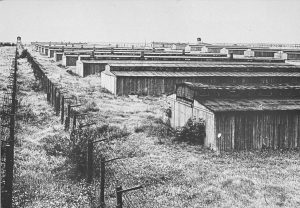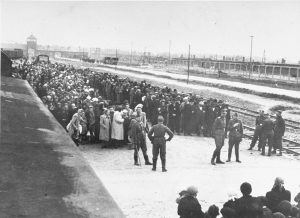Part 4: Mass Incarceration and Extermination (1941-1945)

A section of the prisoners’ barracks in Majdanek, a major extermination camp near the city of Lublin in Nazi-occupied Poland, photograph taken sometime after July 24, 1944. Photo credit: USHMM #73996
The mechanization of Nazi mass murder dramatically increased beginning in 1941, as the Third Reich fought to establish Aryan supremacy and bring a new political order to Europe. This included the liquidation of ghettos, mass deportations, and slaughter of millions. All Jewish people—whom the Nazis considered an existential threat—were singled out for total extermination, which defined the Holocaust. The subjugation of other groups, including Poles, political opponents, and other Slavic peoples, also continued with widespread arrests and mass executions.

Jewish men from Subcarpathian Rus await selection on the ramp at the Auschwitz-Birkenau extermination camp in Nazi-occupied Poland, May 1944. Photo credit: USHMM #77297
The deportation of Jewish people to extermination camps in Poland was a quintessential aspect of the Holocaust. Jews usually arrived by trains consisting of up to 50 cattle cars and came from distances of up to 1,000 miles. During transit, scores of prisoners were tightly packed into the cars for days—shoulder to shoulder—with little food or water, standing in their own urine and feces, and often alongside corpses of those who died along the way.

Jews from Subcarpathian Rus await selection on the ramp at the Auschwitz-Birkenau extermination camp in Nazi-occupied Poland, May 1944. Photo credit: USHMM #77319
Those who survived the transports underwent “selection” upon arrival. First, families were heart-wrenchingly separated as men and older boys were put into one column, while women and children of both sexes were put in another. Then, upon a quickly made decision of Nazi doctors and other camp functionaries, people deemed healthy and fit were designated for forced labor, whereas mothers, children, the elderly, and the weak were selected for immediate murder. Within a couple of hours, the grim process of extermination unfolded: people were usually stripped of their clothing, with their valuables stolen, and immediately sent to gas chambers. At Auschwitz-Birkenau, the selection process was often led by Nazi officer and physician Dr. Josef Mengele (referred to as “The Angel of Death”), who made these decisions using the flick of his thumb: right meant life, while left meant death. Over time, the Nazis murdered so many people that they were forced to construct crematoria (large industrial ovens) to burn and conceal the corpses.
